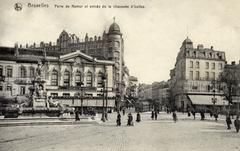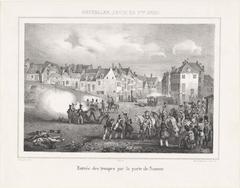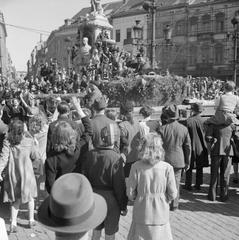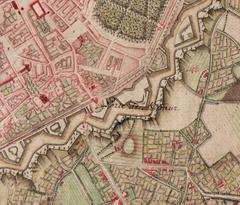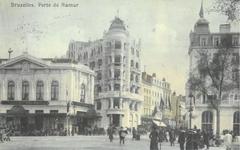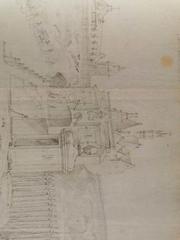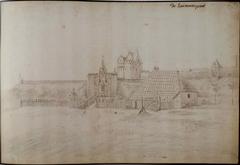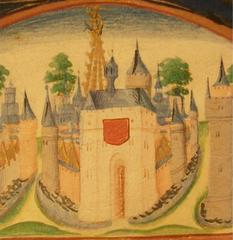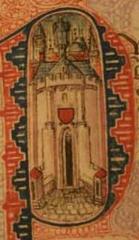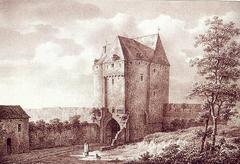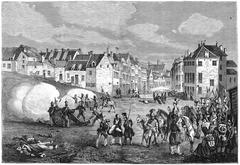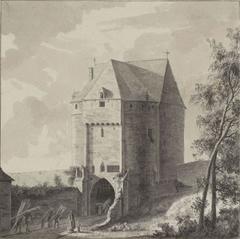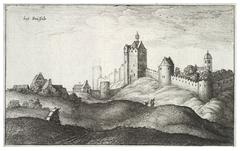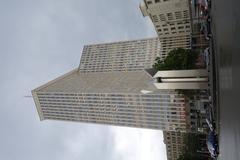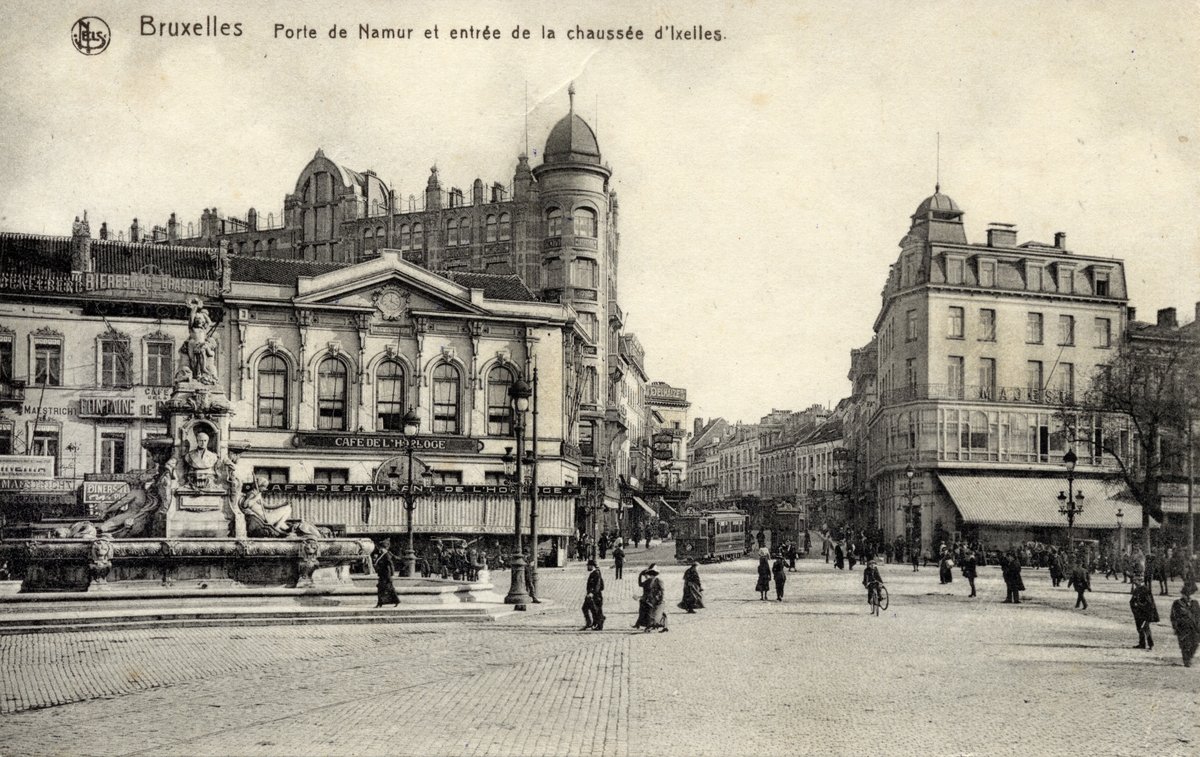
Namur Gate Visiting Hours, Tickets, and Historical Sites in Brussels
Date: 15/06/2025
Introduction
The Namur Gate (French: Porte de Namur; Dutch: Naamsepoort) stands in the heart of Brussels, embodying the city’s medieval heritage and its ongoing urban evolution. Though the original fortifications have long disappeared, the area remains a vibrant commercial and cultural crossroads, fusing centuries of history with modern city life. This comprehensive guide provides detailed insights into the Namur Gate’s historical significance, practical visitor information, accessibility, and essential travel tips, ensuring an enriching experience for every visitor.
For further information, explore trusted resources such as Brussels Official Tourism, Eupedia’s Belgium Guide, and the Brussels City Archives.
Historical Overview
Medieval Foundations
The Namur Gate traces its roots to Brussels’ second set of fortified walls, constructed between 1356 and 1383. Positioned on the city’s southern approach, it was a key gateway, linking Brussels to Namur and the southern Low Countries (Eupedia). This strategic location made the gate vital for commerce, toll collection, and military defense.
Architectural Evolution
Originally, the Namur Gate consisted of robust stone towers flanking an arched central passage, protected by a moat and drawbridge—typical features of medieval fortifications (Eupedia). As military threats waned in the 18th century, its defensive role faded, and urban development transformed the surrounding area.
In 1836, the gate was demolished during the modernization of Brussels. Two neoclassical pavilions were erected as customs posts but were later relocated to Bois de la Cambre after the abolition of the octroi tax in 1860 (Fortifications of Brussels). The monumental Brouckère Fountain subsequently adorned the site from 1866 until its removal in 1955 (Military History Fandom – Namur Gate).
Urban and Cultural Transformation
Post-demolition, the Namur Gate district became a hub for the upper class, artists, and intellectuals, with luxury shops, restaurants, and theaters defining its character. In the 20th century, urban renewal and “Brusselisation” saw the replacement of many historic buildings with modern office complexes and transit infrastructure.
Today, the district is marked by a striking stainless steel structure commemorating the gate, and it remains a bustling intersection at the convergence of Avenue de la Toison d’Or, Chaussée d’Ixelles, and Avenue Louise (Virtourist Brussels Guide).
Cultural and Symbolic Importance
The Namur Gate area continues to symbolize the threshold between Brussels and Wallonia, retaining its legacy through place names and commemorative markers. The district’s evolution from a fortified gateway to a multicultural urban hub mirrors Brussels’ broader transformation into a cosmopolitan capital (Brussels Official Tourism – Namur Gate).
The adjacent Matongé district, renowned for its vibrant African community, further enriches the area’s cultural mix. Festivals, public art, and diverse culinary offerings make Namur Gate a microcosm of Brussels’ multicultural identity.
Practical Visitor Information
Visiting Hours & Tickets
- Namur Gate District: Open public space, accessible 24/7; no ticket or entrance fee required.
- Nearby Attractions: Museums and cultural sites, such as the Royal Museums of Fine Arts and Église Notre-Dame du Sablon, have their own opening hours and ticket policies. For example, the Église Notre-Dame du Sablon is open daily from 9:30 AM to 5:00 PM, with free entry (visit.brussels).
Guided Tours & Events
Guided walking tours of Brussels often include the Namur Gate area, offering insights into medieval fortifications and urban development. Check the Brussels Official Tourism site for updated tour schedules and event listings.
Accessibility
- The area is fully wheelchair accessible, with wide sidewalks, ramps, and accessible public transport stations.
- The Porte de Namur/Naamsepoort metro station (lines 2 and 6) provides direct access.
- Tram and bus lines serve the intersection, and cycling lanes are available for eco-friendly transport (STIB-MIVB Public Transport; Villo! Bike Sharing).
Amenities
- ATMs, public restrooms (mainly in shopping centers/metro stations), and multilingual signage are widely available.
- Shops and restaurants generally operate from 10:00 AM to 7:00 PM; some venues open later.
Safety
The district is generally safe, but visitors should remain vigilant against pickpocketing, especially during busy periods.
What to See and Do
Shopping & Dining
- Avenue de la Toison d’Or: Features luxury boutiques, flagship stores, and a range of dining options (Toison d’Or Shopping Center).
- Matongé District: Discover vibrant African markets, grocers, and restaurants offering Congolese, Senegalese, and Ethiopian cuisine.
Cultural Landmarks
- Royal Museums of Fine Arts: Major museum complex showcasing Belgian and international art.
- Palais de Justice: An imposing neoclassical courthouse with panoramic city views (visit.brussels).
- Église Notre-Dame du Sablon: Notable Gothic church with beautiful stained glass.
Urban Art & Events
- The square and nearby streets often feature murals, street art, and temporary installations (Brussels Mural Project).
- Seasonal events, open-air concerts, and cultural fairs enliven the district, especially in summer and December (Visit Brussels Events Calendar).
Getting There
- Metro: Porte de Namur/Naamsepoort (lines 2 & 6).
- Bus/Tram: Multiple lines connect the area with central Brussels and neighboring districts.
- Cycling/Walking: Dedicated lanes and pedestrian-friendly infrastructure make it easy to explore on foot or by bike.
Frequently Asked Questions (FAQ)
Q: Are there tickets required to visit Namur Gate?
A: No, the district is an open public area with free access. Tickets may be required for museums or guided tours.
Q: What are the visiting hours?
A: The Namur Gate area is accessible 24/7. Shops and restaurants typically operate from 10:00 AM to 7:00 PM.
Q: Is the area accessible for visitors with disabilities?
A: Yes, most spaces, including public transport and shopping centers, are equipped for accessibility.
Q: How do I get to Namur Gate?
A: Use the Porte de Namur metro station or various tram/bus lines.
Q: Are guided tours available?
A: Yes, many local operators and the tourism office offer walking tours of the district.
Visual Highlights
Recommendations for a Memorable Visit
- Visit on weekdays for a relaxed atmosphere.
- Combine your visit with nearby museums and attractions in the Royal Quarter.
- Join a walking tour for historical insights and access to hidden gems.
- Sample local cuisine in both the Toison d’Or and Matongé districts.
- Enjoy seasonal events and public art installations for a dynamic urban experience.
Sustainability and Responsible Tourism
Use public transport, walk, or cycle to minimize your environmental footprint. Support local businesses and participate in sustainability initiatives when possible (brussels.be – Sustainable Brussels).
Conclusion
The Namur Gate is much more than a historical reference point; it is a living district where Brussels’ rich past and vibrant present converge. From its medieval origins to its role as a modern commercial and cultural center, the area offers something for every visitor—history, shopping, art, cuisine, and community. Whether you’re a first-time traveler or a seasoned explorer, the Namur Gate provides a unique gateway into the layered narrative of Brussels.
Download the Audiala app for guided audio tours and insider tips. For the latest updates, events, and detailed travel information, consult the official Brussels tourism website. Discover even more about Brussels’ medieval fortifications, cultural festivals, and neighborhoods through curated articles and official resources.
Sources and Further Reading
- Eupedia Belgium Guide
- Brussels Official Tourism – Namur Gate
- Brussels City Archives
- Fortifications of Brussels
- Virtourist Brussels Guide
- Military History Fandom – Namur Gate
- STIB-MIVB Public Transport
- Villo! Bike Sharing
- Brussels Mural Project
- Toison d’Or Shopping Center
